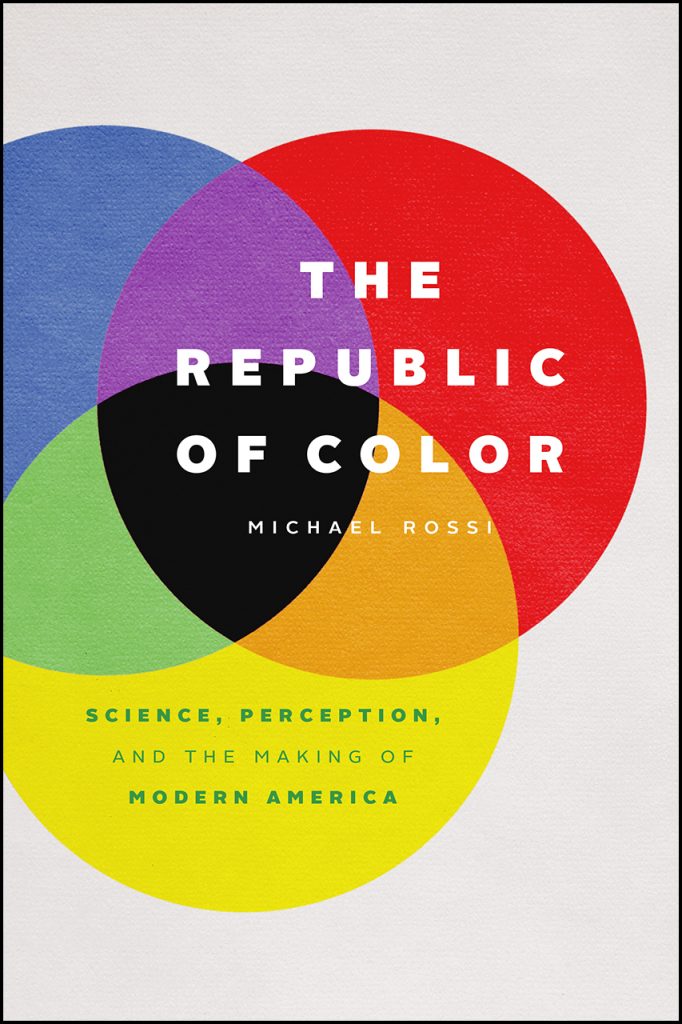6 Questions with Michael Rossi, author of “The Republic of Color: Science, Perception, and the Making of Modern America”
In Michael Rossi’s compelling new history, The Republic of Color, he shows readers how the control and regulation of color shaped the social contours of modern America—and redefined the way we see the world. We sent Rossi a few questions to learn more about color science and how it affects us today.
First, can you give us a quick introduction to the “republic of color”—what does this term describe?

As you might know, “the Republic of Color” was not the original title for the book. Credit goes to Prof. Kathleen Belew for coming up with the felicitous wording over dinner after a workshop session. Credit also to numerous other readers, colleagues, and friends who convinced me that my own titular ideas were obtuse and/or confusing. Thank you, all!
This said, “the Republic of Color” works so well as a title because it emphasizes that the book is about color and politics. Rather than simply an ideologically neutral fact about the visual world, color perception—and especially scientific research about how human beings see, experience, and talk about color (or not)—was an important part of the project of American statecraft at the turn of the century. Instead of being ancillary to politics, aesthetics—in this instance, in the form of scientific understandings of color perception—was essential to how various groups of Americans thought about what an industrialized society should be like. The title captures this central thesis of the book well, I think.
How did you wind up in the field of color science, and what do you love about it?
Before going to graduate school, I spent several years working as a graphic designer. This career choice itself came from a long-standing obsession with design and painting. When I started my PhD work, I’d had it with design, and swore that I’d do something new—something completely unrelated to art or design. I failed in this respect.
Part of why this failure doesn’t chafe is that the history of color science turned out to be constantly surprising. The ways in which people have historically understood their own sensations and those of others are limitless in number and bottomless in creativity. Writing about the history of color science is a way of always stepping into new worlds, great and small, delightful and horrible.
While you were working on this project, what did you learn that surprised you the most?
Too many things to choose just one (see answer, above). In terms of big discoveries, the connections between color science and the American school of philosophy called pragmatism were stunning and form the basis of the book’s chapter 2. And the debts that our contemporary notions of multiculturalism owe to color blindness research are still exciting to me to think about (and form the basis of chapter 4). In terms of smaller discoveries, in going through boxes of archival documents—letters, diaries, lists, notes, etc.—one also learns a lot of unexpected things about one’s subjects: about their foibles, their vanities, the things they find funny, the things they love, how they make and break friendships, how they manage working and family relationships and so forth. These were endlessly surprising, and a constant reminder that the long-dead people I was writing about—people that now only existed to me as collections of documents—once had rich, interior lives that I could only begin to fathom.
Did your research turn up anything interesting that didn’t make it into the final manuscript?
Again, too many things to list. Quite a few visual materials, for instance, didn’t make it—lost paintings, sketches, charts and graphs . . . all made a century ago or more in the service of promoting newly rationalized ideas about color and science. There were also some people who I wanted to include, and had even written substantial parts of chapters around, who ultimately didn’t fit. An anthropologist with a mania for measuring ants and people alike, for instance, had to stay on the sidelines. An early twentieth-century doctor with a portfolio of theories about color blindness and sexuality sat the text out, too. Physician, eugenicist, and social reformer Havelock Ellis never got to experiment with mescaline in the pages of the published book, sadly.
The book mentions that color “. . . expresses itself through techniques and technologies which themselves shape human societies.” In 2019, what are the techniques and technologies that shape American society the most? Did your research turn up anything interesting that didn’t make it into the final manuscript?
An obvious answer would probably involve some sort of social media technologies, with all of their much-commented-on world-making and truth-warping capabilities. I can’t help but wonder, however, if our contemporary understandings of the ways in which language, attention, emotion, affect, and trust work are not themselves predicated on earlier technologies—particularly those derived from linguistics, physiology, genetics, and other technologies of the body in the mid–late twentieth-century. This, anyway, is the premise of my new book, which looks at the ways in which changes in the fields of language studies (e.g. speech pathology; formal linguistics) shaped and were shaped by ideas about human nature and human character over the past hundred (or so) years.
What’s the best book you’ve read lately?
I re-read Middlemarch every summer. That’s a pretty good one.

Michael Rossi is assistant professor of the history of science and medicine at the University of Chicago.
The Republic of Color is available now on our website or from other booksellers.